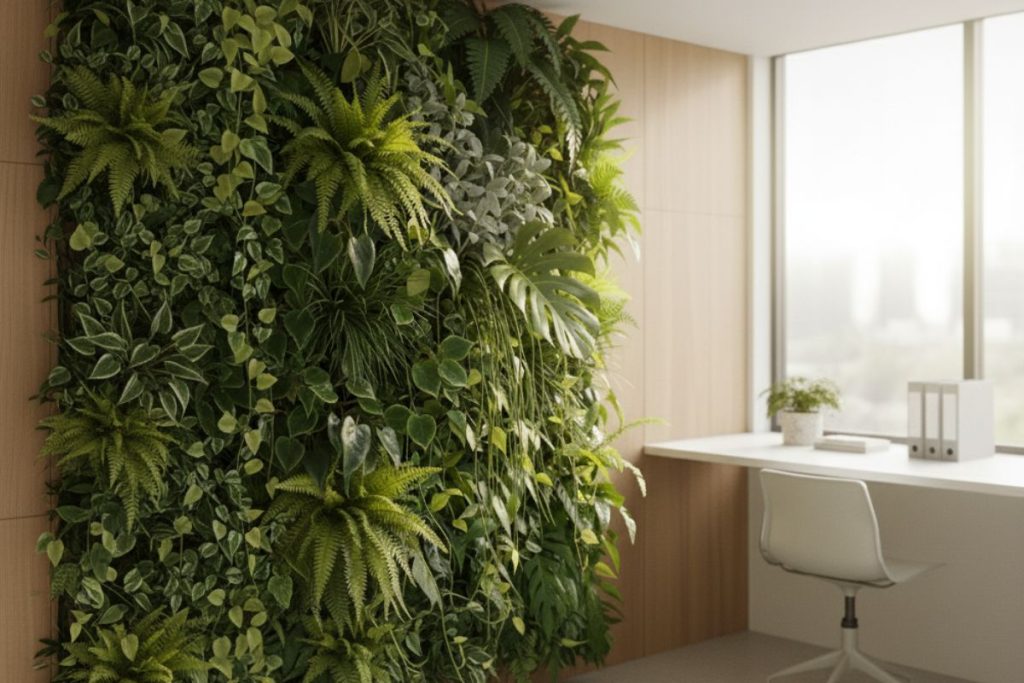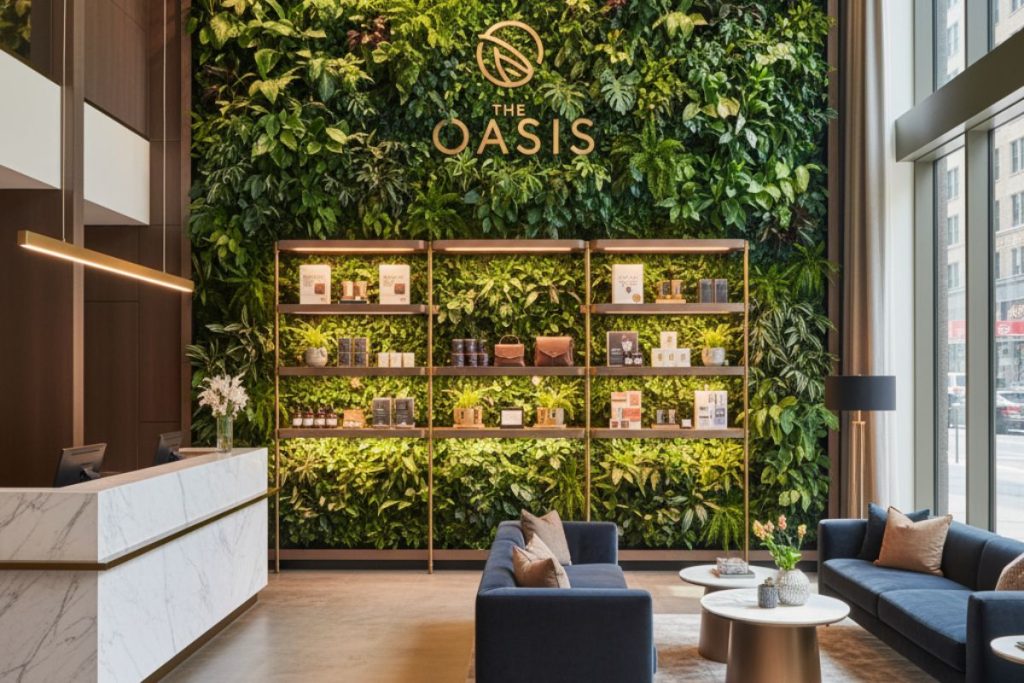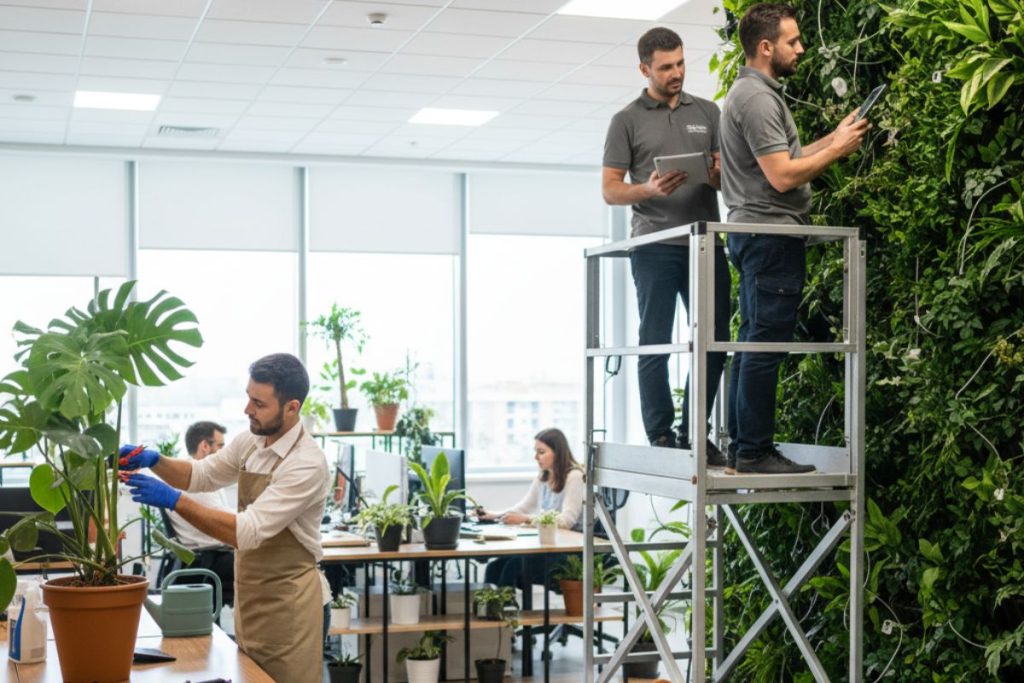When Australian businesses consider bringing nature indoors, the choice between living walls and traditional plant hire can dramatically impact both your bottom line and your workplace environment. While both approaches offer unique benefits, understanding the economic advantages, installation realities, and long-term financial returns will help you make the smartest investment for your commercial space.
After decades of transforming Australian offices, retail spaces, and corporate environments, we’ve witnessed firsthand how both solutions perform in our unique climate and business landscape. Let’s explore which option delivers the best results for your specific goals and budget.
What Is a Living Wall?
A living wall, also known as a green wall or vertical garden, is a self-contained ecosystem that transforms ordinary wall surfaces into thriving vertical landscapes. These installations feature real plants growing in specially designed structures that include integrated irrigation systems, drainage, and often automated monitoring technology.
Unlike traditional wall-mounted planters or climbing vines, living walls create complete vertical gardens that can support dozens or even hundreds of plants in a single installation. Modern systems range from modular panels that can be easily installed and maintained, to custom-built installations that become architectural features of the space.

Key Components of Living Walls:
- Structural support systems designed to handle plant weight and water
- Integrated irrigation networks with automatic watering capabilities
- Drainage systems to prevent water damage
- Growing mediums specifically formulated for vertical gardening
- Plant selection tailored to indoor lighting and climate conditions
In the Australian context, living walls have evolved to work exceptionally well in our climate-controlled commercial buildings, taking advantage of consistent indoor temperatures while providing the visual impact and air quality benefits that our increasingly urbanised workforce craves.
The technology behind modern living walls addresses the traditional challenges of vertical gardening, making them viable long-term installations rather than high-maintenance experiments.
The Economic Benefits of Green Walls: A Smart Investment for Australian Business
The economic case for living walls extends far beyond their visual appeal, delivering measurable financial returns that make them compelling business investments rather than simple decorative expenses.
Increased Property Value and Market Appeal
Living walls significantly boost commercial property values and rental appeal in Australia’s competitive real estate market. Quality landscape design and biophilic elements can generate up to 109 percent return on every dollar spent, with living walls representing one of the most impactful interventions available.
Property Value Benefits Include:
- Enhanced building aesthetics that command premium lease rates
- Improved Green Star and NABERS ratings that attract environmentally conscious tenants
- Distinctive features that set properties apart in competitive markets
- Long-term asset appreciation through sustainable building features
Australian commercial property managers report that buildings with prominent biophilic design elements, including living walls, can charge 3-7% higher rents and experience reduced vacancy periods. This premium reflects growing tenant demand for healthy, sustainable work environments.
For property investors, living walls represent capital improvements that deliver both immediate rental advantages and long-term asset value growth, particularly as environmental sustainability becomes increasingly important in commercial lease decisions.

Retail Revenue Enhancement Through Biophilic Design
The retail sector sees some of the most dramatic economic benefits from living walls. Biophilic store design incorporates natural elements to improve consumer experience and ultimately translate this into increased revenue. Australian retailers implementing living walls report significant improvements in customer behaviour and purchasing patterns.
Retail Performance Improvements:
- Increased customer dwell time in stores with natural elements
- Higher average transaction values in biophilic retail environments
- Enhanced social media engagement and word-of-mouth marketing
- Improved customer satisfaction scores and return visit rates
The psychological impact of natural environments on shopping behaviour is well-documented, with customers spending more time and money in spaces that incorporate living plants. For Australian retailers, living walls create Instagram-worthy backdrops that encourage social sharing while providing the calming atmosphere that promotes unhurried shopping experiences.
Restaurant and hospitality businesses see particularly strong returns, with living walls creating distinctive dining atmospheres that justify premium pricing and encourage longer stays.
Enhanced Workplace Efficiency and Productivity
Living walls deliver measurable productivity improvements that directly impact business performance. In Australia’s knowledge-based economy, where labour costs represent the largest expense for most businesses, even small productivity gains create substantial economic value.
Workplace Performance Benefits:
- Reduced employee sick leave through improved air quality
- Enhanced focus and cognitive performance in plant-rich environments
- Lower stress levels and improved employee satisfaction scores
- Increased creativity and problem-solving abilities
Australian businesses report that employees in offices with living walls show measurably improved attendance rates and job satisfaction scores. The air-purifying effects of living walls contribute to healthier work environments, while the visual connection to nature reduces the psychological stress associated with urban office environments.
For businesses where employee retention is costly, living walls contribute to workplace cultures that help attract and retain top talent, delivering long-term savings in recruitment and training costs.
Reduced Air Conditioning and Energy Costs
In Australia’s climate, air conditioning represents a significant operational expense for commercial buildings. Living walls provide natural cooling and insulation properties that reduce HVAC energy requirements throughout the year.
Energy Efficiency Benefits:
- Natural insulation that reduces heating and cooling loads
- Evapotranspiration effects that cool surrounding air naturally
- Improved indoor humidity regulation reducing HVAC workload
- Potential energy savings of 15-30% in areas adjacent to living walls
The thermal mass and evapotranspiration effects of living walls help moderate indoor temperatures, reducing the load on mechanical climate control systems. This is particularly valuable in Australian commercial buildings where air conditioning costs can represent 30-40% of total energy expenses.
Buildings with extensive living wall installations report measurable reductions in energy consumption, with savings accumulating over the installation’s lifetime to deliver significant operational cost reductions.
Australian Government Subsidies and Tax Benefits
The Australian government actively supports sustainable building improvements through various incentive programs that can substantially offset living wall installation costs.
Businesses can claim a bonus tax deduction of 50 per cent of the cost of eligible assets or capital works, with this initiative expected to provide around $1 billion in support for greening existing buildings. Depreciation and capital works deductions may apply to vertical garden installations, while Green Star and NABERS ratings improvements can increase building value and appeal to eco-conscious tenants.
Available Financial Incentives:
- Federal tax deductions for sustainable building improvements
- State-based grants for energy efficiency upgrades
- Local council incentives for green building initiatives
- Accelerated depreciation schedules for eligible installations
Cities across Australia offer additional support programs. Sydney, Melbourne, and Brisbane have specific green building grant programs that can help offset installation costs, while the federal government’s broader sustainability initiatives provide tax advantages for qualifying improvements.
These incentives can reduce the effective cost of living wall installations by 30-50%, dramatically improving the return on investment and making living walls financially attractive for a broader range of businesses.
Traditional Plant Hire: Flexibility Meets Predictable Value
Traditional plant hire operates on a fundamentally different economic model that prioritises cash flow management and operational flexibility over the dramatic impact of living walls.
Financial Structure Benefits:
- No upfront capital investment required
- Predictable monthly expenses that include all maintenance
- Ability to scale plant installations up or down as needed
- Tax-deductible operational expenses rather than capital investments
Traditional plant hire typically costs $15-50 per plant monthly, making a comprehensive office installation affordable for businesses of all sizes. This model provides immediate tax benefits as operational expenses while avoiding the capital allocation challenges of living wall installations.
Operational Advantages:
- Professional maintenance included in monthly fees
- Immediate plant replacement when needed
- Seasonal rotation to maintain visual interest
- Flexibility to reconfigure as office layouts change
For businesses with limited capital budgets or uncertain long-term occupancy, traditional plant hire delivers many of the wellness and productivity benefits of living walls without the substantial upfront investment or long-term commitment.

Making the Smart Investment Decision
The choice between living walls and traditional plant hire ultimately depends on your business objectives, financial structure, and long-term vision for your space.
Choose Living Walls When:
- You own your commercial property or have long-term leases
- Capital investment can be justified by property value increases
- Maximum visual impact and brand differentiation are important
- Government incentives make the investment particularly attractive
- Energy savings and sustainability credentials align with business goals
Choose Traditional Plant Hire When:
- Cash flow considerations favour predictable monthly expenses
- Flexibility to change or expand plant installations is important
- You’re renting space with uncertain long-term occupancy
- Smaller-scale plant integration meets your wellness objectives
- Professional maintenance without capital commitment is preferred
Many successful Australian businesses combine both approaches, using traditional plant hire for flexible day-to-day greenery while incorporating living wall features in high-impact areas where the investment can be justified by property value increases and marketing benefits.
The most effective green investments align with your business model, financial capacity, and long-term property strategy. Whether you choose the dramatic impact of living walls or the flexible reliability of traditional plant hire, both options can deliver measurable improvements to your workplace environment and business performance.
Understanding these economic realities helps Australian businesses make informed decisions that deliver real value while creating healthier, more productive work environments for their teams.

Devils ivy in custom planter with wire by Gaddy’s.
If you’re interested in customising your own space with green walls, take a look at Gaddy’s green wall offerings and contact our team for a free on-site consultation. We offer vertical green walls, moss walls, and bespoke plant solutions.
References
- Australian Parliament House. Tax breaks for green buildings. Retrieved from https://parlinfo.aph.gov.au/parlInfo/search/display/display.w3p;query=Id:”library/partypol/8RGX6″
- SMI National. (2020). Living Walls increase Property Value. Retrieved from https://www.sminational.com.au/blogs/living-walls-increase-property-value
- In Situ Plants. (2022). Sell More With Plants: Biophilic Store Design and the Retail Environment. Retrieved from https://www.insituplants.com/blog/sell-more-with-plants-biophilic-store-design-and-the-retail-environment/
- Indoor Plant Solutions. (2025). Why Green Walls are the Future of Australian Office Designs. Retrieved from https://indoorplantsolutions.com.au/green-walls-in-the-workplace-elevating-australian-office-design/
